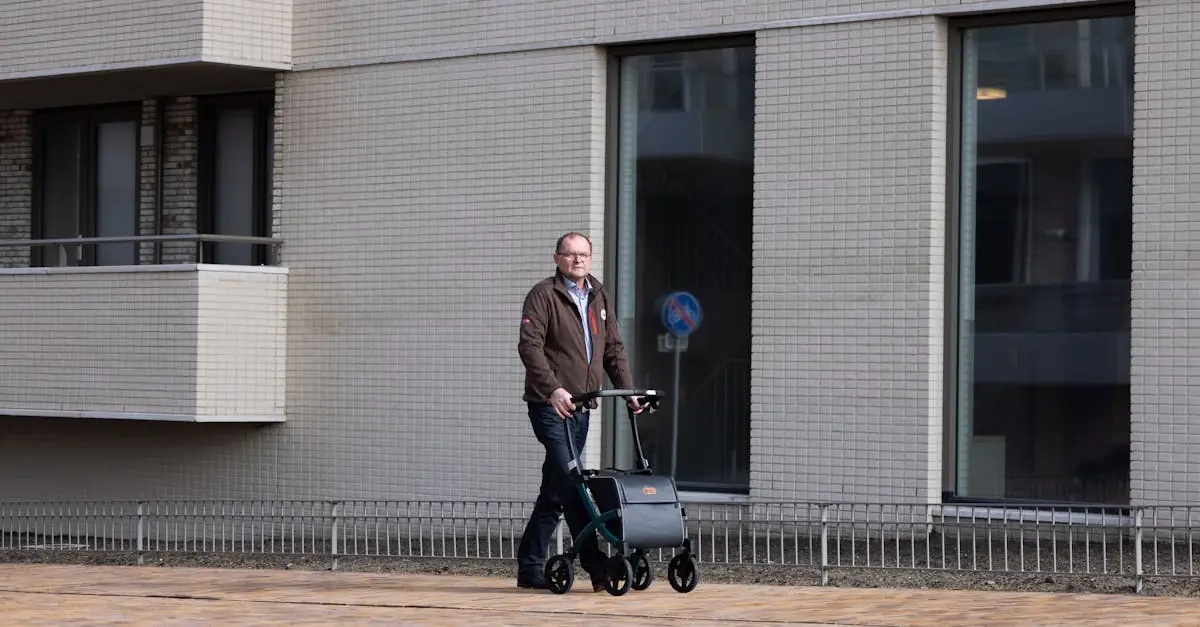Imagine trading in the suburban sprawl for a vibrant cityscape where every day feels like an adventure. Urban retirement living offers retirees a chance to swap lawnmowers for latte art and backyard barbecues for rooftop brunches. It’s not just about finding a place to live; it’s about embracing a lifestyle filled with culture, convenience, and, let’s be honest, a bit of chaos that keeps things interesting.
In the heart of the city, retirees discover a treasure trove of activities, from art galleries to gourmet food trucks. Urban living isn’t just a trend; it’s a way to stay engaged and youthful. So why settle for the same old routine when the city beckons with its endless opportunities? It’s time to kick back, explore, and redefine what retirement really means. After all, who says you can’t have fun while enjoying your golden years?
Table of Contents
ToggleOverview Of Urban Retirement Living
Urban retirement living offers a dynamic lifestyle for retirees seeking excitement and engagement. In city environments, access to diverse activities enhances daily life. Residents explore local museums, attend concerts, and enjoy open-air markets, ensuring no two days feel the same.
The transit systems in urban areas make travel convenient. Retirees enjoy easy access to public transportation, allowing them to visit various attractions without needing a car. Proximity to healthcare facilities remains a priority, providing peace of mind for residents.
Diverse social networks form naturally in these settings. Many retirees find opportunities to connect with like-minded individuals through clubs, classes, or community events. This fosters a sense of belonging, reducing feelings of isolation often experienced in suburban living.
Affordable housing options cater to different budgets. Many urban areas feature senior living communities that prioritize comfort and security while promoting independence. These facilities often include amenities like fitness centers and organized activities tailored to retirees’ interests.
Safety measures in urban environments play a crucial role in retirement living. Neighborhoods usually invest in well-lit streets and community policing, enhancing residents’ sense of security. Additionally, the availability of social services supports retirees in navigating their daily lives.
Nature is not forgotten in urban settings. Parks and green spaces provide a refreshing escape from the bustling city. Many retirees take advantage of these areas for relaxation and outdoor activities, contributing to their overall well-being.
Urban retirement living truly reflects a vibrant and fulfilling lifestyle, redefining what it means to enjoy one’s golden years.
Benefits Of Urban Retirement Living
Urban retirement living offers retirees enhanced experiences in their golden years. The vibrant city environment promotes engagement and fulfillment.
Access To Amenities
Convenience defines urban living for retirees. Shops, restaurants, and healthcare facilities often exist within walking distance. Parks, gyms, and cultural centers also enhance living experiences. Easy access to public transportation simplifies exploration of the city. Retirees enjoy seamless connections to theaters, art galleries, and museums. Diverse dining options cater to various tastes, promoting culinary adventure. Quality healthcare facilities, frequently located nearby, provide peace of mind. A multitude of amenities ensures retirees lead dynamic and active lifestyles.
Social Opportunities
Social connectivity thrives in urban settings. Retirees can join clubs and community groups that match their interests. Art classes, book clubs, and gardening groups foster lasting friendships. Frequent city events, like festivals and concerts, create opportunities to engage with others. Local coffee shops and public spaces serve as meeting points for socializing. Diverse backgrounds of fellow residents promote rich interactions and cultural exchanges. Joining community events often minimizes feelings of isolation, enhancing overall well-being. The vibrant social scene in urban areas encourages active participation, enriching retirement experiences.
Challenges Of Urban Retirement Living
Urban retirement living presents several challenges that can impact retirees’ experiences. Understanding these obstacles helps in making informed decisions.
Cost Of Living
Urban areas often have a higher cost of living compared to suburban settings. Expenses related to housing, groceries, and services can strain retirees’ budgets. Significant differences in rent can be evident, with some city apartments costing 30% to 40% more than similar options in suburban neighborhoods. While urban living provides access to amenities, these conveniences often come at a premium. Moreover, retirees may find it challenging to manage fluctuating costs in essential services. High demand for housing can lead to limited availability, further driving up prices.
Space And Privacy Issues
Limited space in urban environments poses a unique challenge. Apartment living often means smaller units, which can restrict personal space. Shared facilities may reduce privacy, impacting comfort. Many seniors prefer having dedicated areas for hobbies or relaxing. Noise levels can also be higher, leading to disturbances from traffic and social activities. While some buildings offer communal areas, the lack of exclusivity may not suit everyone’s preferences. Maintaining personal space in densely populated cities can become an ongoing concern for retirees.
Popular Cities For Urban Retirement Living
Urban retirement living attracts retirees seeking an exciting lifestyle. Several cities stand out for their vibrant amenities and supportive environments.
City 1: Overview And Highlights
New York City offers a dynamic retirement experience. Cultural institutions abound, from renowned museums to theater productions. Public transportation simplifies travel, making exploration convenient. Retirees find diverse culinary options, with everything from street food to Michelin-starred restaurants. Parks, like Central Park, provide green space for relaxation and recreation. Fitness classes and art programs ensure ongoing engagement. Active social scenes thrive, with numerous clubs and events encouraging connections. Overall, the city’s energy enriches retirees’ lives.
City 2: Overview And Highlights
San Francisco boasts stunning views and a mild climate. The arts scene flourishes, with local galleries and music festivals enhancing the cultural landscape. Accessible public transport allows easy access to various neighborhoods and attractions. Culinary diversity reflects the city’s rich history, from food trucks to award-winning dining. Community gardens and waterfront areas offer tranquility amidst the urban setting. Retirees often engage in educational opportunities and volunteer work, fostering a sense of purpose. Social clubs and recreational activities promote friendships, making retirement enjoyable in this picturesque city.
Tips For Choosing An Urban Retirement Community
Evaluating the location is crucial. Retirees should consider proximity to essential services, such as healthcare facilities, grocery stores, and recreational areas. Researching neighborhood safety also plays a significant role in ensuring peace of mind.
Assessing available amenities matters. Features like fitness centers, communal spaces, and organized activities enhance lifestyle quality. Communities offering additional services, such as meal plans or transportation options, provide further convenience.
Understanding the community’s culture is essential. Engaging with current residents can reveal insights about social dynamics and overall satisfaction. Participating in community events allows potential residents to gauge if the environment aligns with their interests.
Exploring the financial aspects helps in budgeting. Identifying potential costs, including monthly fees and hidden expenses, creates a clearer financial picture. Seeking clarity on housing options, such as apartments or shared homes, contributes to informed decision-making.
Reviewing accessibility features is beneficial. Consideration of accessibility for mobility challenges ensures comfort and ease of movement within the community. Communities designed with seniors in mind often incorporate features that promote independence.
Identifying social opportunities enhances the decision process. Communities offering clubs and groups tailored to various interests encourage friendships and social interaction. Vibrant social networks enable retirees to stay engaged and connected.
Evaluating transportation options is crucial for urban living. Availability of public transit supports exploration of the city and reduces reliance on personal vehicles. Communities that facilitate easy access to transportation options open up numerous possibilities for residents.
Prioritizing these considerations leads to informed choices. Retirees can navigate the urban retirement landscape effectively, ensuring their new community enhances their lifestyle and meets their needs.
Conclusion
Urban retirement living offers a vibrant alternative to traditional retirement options. With its rich cultural experiences and diverse social opportunities, retirees can find fulfillment and excitement in their golden years. The benefits of easy access to amenities and engaging activities enhance overall well-being while fostering meaningful connections.
Despite some challenges related to cost and space, the dynamic lifestyle and supportive communities available in urban settings make them appealing choices. By carefully evaluating their options and aligning their needs with the right urban environment, retirees can embrace this new chapter with confidence. Ultimately, urban retirement living redefines what it means to enjoy life after work, encouraging exploration and adventure in every moment.


